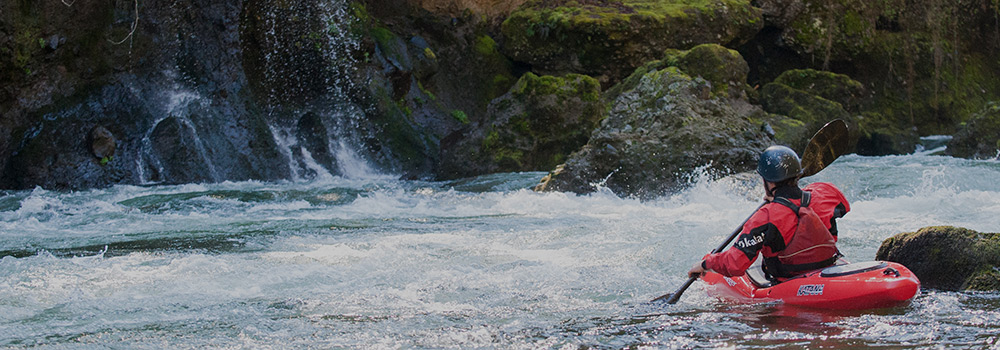Reposted from the Dagger blog, written by Laura Farrell
** These maneuvers are mostly applicable to whitewater kayaks
Ok, so you just bought a kayak, but now you’re wondering how you’re going to get it home on your car. Or maybe you’ve figured out how to carry one boat, but now you’re headed to the river with four of your friends and you have to carry their boats too. The process of loading boats onto a vehicle can be a bit overwhelming at times, especially the first time you try to carry a load you’re not used to. For those people that fall into this category, I have laid out the best and most common ways to carry a boat on your car, as well as some tips of the trade to help you out.
However, before we get started, you need to understand the different pieces of equipment that are either necessary or very helpful to the process…
The Rack
This could be a factory rack, or a rack that is mounted to your vehicle either onto your pre-existing factory rack or another part of your vehicle. Check out Yakima or Store Your Board for racks.
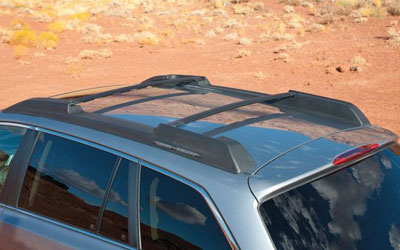
The tie-down mechanism
This could either be a cam strap or a piece of rope (or in some cases maybe it’s a throw bag). If you choose to use rope, you will need to learn how to tie a trucker’s hitch knot. Check out this Youtube video to learn how Trucker's Hitch Video. Some techniques only require one piece while others require two.
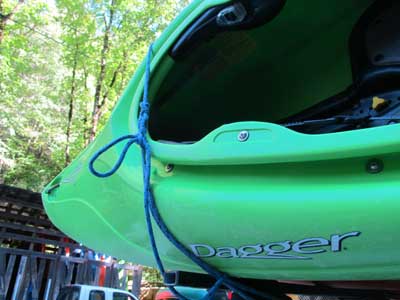
The Stacker
While by no means completely necessary, this piece of equipment allows for much easier loading and a larger carrying capacity in most cases. If you don’t know what a stacker is, check out Yakima Stackers for a full description. Because not everyone has stackers, I will share techniques to carrying boats both with or without them.

Ok so now you’re ready to load some boats. Check out the various formations shown below. I have tried to show an array of options, both with a factory rack or a custom rack, a rope or a strap or a stacker or not.
The One Boat Load, hull down
If you only have one boat you need to carry and you have one strap or rope available; This technique is used a lot because its quick and easy, but the downside is that the boat lying on the crossbars can cause oil canning if left in this position for long, especially if its hot out. Two boats can also be tied side by side in this manner if your crossbars are wide enough.
- Get your rope or cam set up by laying it out on the roof of the vehicle in the center, parallel to the vehicle, under both crossbars
- Lay the kayak flat on the crossbars (hull down) on one side of the bars.
- Bring both ends of the cam up and around the kayak (it is best you can thread at least one of these through a security bar on the kayak)
- Set the strap so the cam buckle sits around the top of the kayak (which should mean that your non-buckle side has more length to it)
- Bring the non-buckle part of the strap under the crossbars and thread it through the buckle and tighten

The Standard Stacker Stack
If you have stackers, two ropes or straps and want to carry 1-5 boats; This technique can be used with either factory racks or custom racks, but keep in mind, the longer the crossbar the more boats you can carry.
- Get your straps set around each of your stackers first (it will be easier this way)
- Load your first boat with the hull against the stackers
- Load the rest of your boats against the first boat (in most cases it is best if you also alternate bow forward to stern forward, a technique generally referred to as the 69).
- When you’ve loaded all your boats, bring both sides of the straps or ropes around the boats, hook one end under your rack and bring it to the other end.
- If you’re using rope, tie a truckers hitch now. If you’re using cam straps, bring the end through the cam and crank it down tight.


The One Boat Load, cockpit down
If you are worried about oil canning your boat, use this technique instead of the hull down version; This is also a good technique if you think it might rain and you don’t want your kayak to fill up with water. The only down side to this technique is that the security bars are not accessible so you need to make sure the boat is very secure. While it can be done with only one strap, two is better for extra security (to do this just set one strap under the front crossbar and the second under the back crossbar) It is done the same way as the one boat hull down technique shown above, but this time with the cockpit down as the name describes.

The Double Stack (69 style)
If you don’t have stackers, but have two ropes or straps, and want to carry 2-4 boats; This technique works more or less the same as the One Boat Load, but this time you will be stacking another boat on top, cockpit to cockpit, bow to stern. While possible with just one strap, it is much better to use two for extra security. This can also be done with two double stacks side by side if the crossbars are wide enough.
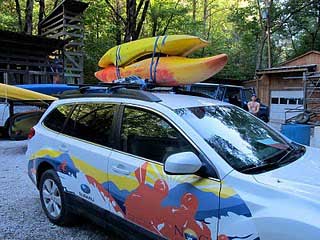
The Side by Side No Stacker Stack
If you don’t have stackers and need to carry a lot of boats; This technique can be used for loading lots of boats when you have one of those friends who is too cheap to buy stackers; It is not overly difficult, but does require the help of some fellow boats for balancing the load. Basically you’re going to stand one boat on its side and use it like you would a stacker (attaching the ropes or cams around the rack, instead of the stacker). Because of the lack of stacker, someone is going to have to hold the boat up while the rest are being loaded (load the same as you would with the stacker method). Sometimes this technique also includes the Around the World variation, which involves sending the rope over and under the entire stack instead of looping it around the rack (the Around the World technique is used when you don’t have a strap or rope long enough to do it the normal way).
The Stack ‘em High Stack
When you only have one shuttle vehicle, but lots of friends that need a ride! While not exactly recommended, you may see some crazy stacks out there when shuttle vehicles start running low. Anytime you stack on a stack, or decide to go crazy with your stacking, make sure you’re careful about securing the bow and the sterns really well!
Below you will find some pictures of various loading techniques that I’ve been a part of in my paddling career, some more recommended than others! Don’t forget to add bow and/or stern lines to your loads for extra safety.
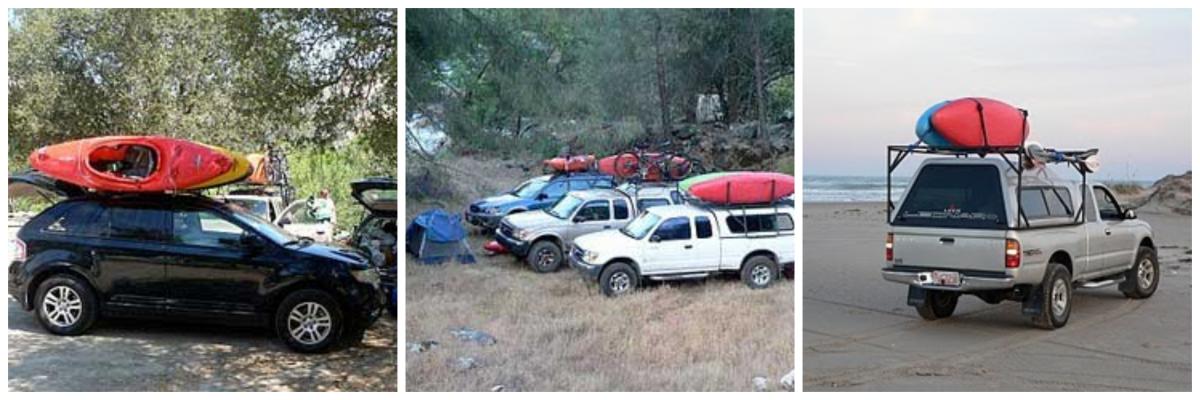
MORE TO EXPLORE

